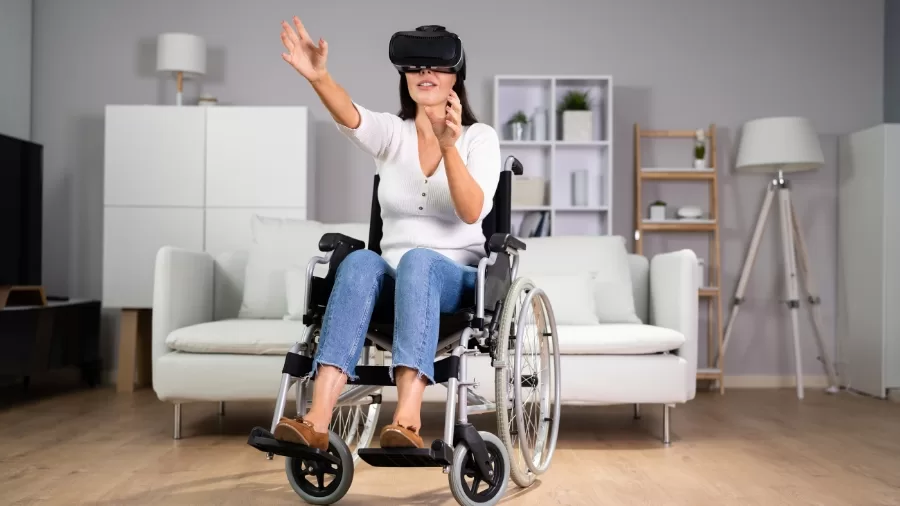Health
How Virtual Reality is Revolutionising Therapy and Healthcare

- It gives immersive therapy experience for mental health disorders like depression, anxiety, PTSD, and phobias; this is accomplished under control through virtual reality.
- In the domain of physical rehabilitation, VR opens up the possibility of activating and engaging in exercises where patients acquire mobility and manage chronic pain.
- Alongside this, it is advancing cognitive therapy with therapeutic environments through a personalized-tuning approach that boosts engagement and progress in therapy.
Virtual Reality (VR) is now not limited to gaming or entertainment. Over the last few years, it has opened a different chapter for itself in the therapy world, the way it is revolutionizing the treatment of both mental and physical health issues. Carefully designed virtual environments in which patients become immersed offer therapy in a new way, resulting in truly amazing results. Therapy for a broadening spectrum of uses-from anxiety and PTSD to physical rehabilitation holds a lot of increasing promise.
The Growth of VR Therapy
The concept of employing VR for therapeutic purposes first gained popularity in the early 2000s. Initially, it was meant to treat specific phobias, such as a fear of heights or spiders, by allowing regulated exposure. However, with the rapid growth of VR technology, its applications have grown substantially. Today, virtual reality is being used to treat a variety of mental health and physical rehabilitation difficulties, providing a non-invasive and engaging therapeutic option.
Virtual Reality for Treating Mental Health Issues
It is in the treatment of mental health disorders that VR shows perhaps its most significant promise. Today, virtual reality exposure therapy (VRET) has become one of the most effective treatment methods for anxiety disorders, PTSD, and phobia. “Exposure” to a given frightening scenario inside a virtual environment allows therapists to continually expose patients to phobia-evoking stimuli in a safe and controlled manner. This whole process leads patients to confront their anxieties and fears via exposure therapy. It mostly results in an impressive improvement in mental well-being.
For example, a patient with PTSD who may have been ‘fighting in the jungles of Vietnam’ can be engaged in a simulated battlefield where everything is poly-lethal and replays in his mind so that he can identify it with what is happening in the therapy setting. This affords him the chance to do a process in a non-threatening environment where the therapist will be available. Over time, the patient is then desensitized to the trauma by gradually exposing them to the events in the simulation with reduced symptoms such as nightmares, anxiety and flashbacks.
Its benefits are also being derived in the treatment of anxiety and panic disorders. In addition, patients are brought up in several real-life scenarios where feeling crowded seems unbearable, and perhaps even participating in social events might sound unimaginable. The longer they stay in the virtual world, the more they learn how to deal with their thoughts in those otherwise real-life situations.
Helping with Physical Rehabilitation
In addition to mental health, VR is gaining traction in physical treatment and rehabilitation. Patients recovering from injuries or surgeries can participate in VR exercises that stimulate muscular movement and brain activity, allowing them to restore mobility and strength in a more fun manner. Traditional therapy can be repetitive and uncomfortable, but virtual reality provides a fascinating and participatory alternative.
For example, individuals who have had a stroke may play VR games that stimulate them to use their arms and legs, so encouraging motor function rehabilitation. These games are not only personalised to each individual’s rehabilitation needs but they are also intended to keep patients motivated and focused on their recovery, making the process less tedious and more enjoyable.
Actually, is used in pain management for long-term chronic conditions. It enables the patient to distract his mind from pain and discomfort to something more positive and therapeutic. This is applicable, especially for several cases of fibromyalgia or lumbago, where the typical patient experiences pains that are persistent and debilitating.
VR as a Supplement for Cognitive Therapy
Another area in which VR seems useful is cognitive therapy of course. Cognitive therapy aims at helping patients change the negative thought patterns in their minds. In VR cognitive behavioural therapy (CBT), patients can interact in simulated environments completing challenges to situations which are relevant to the struggle that they are facing within themselves. So for example, an individual with social anxiety might attend a virtual social gathering to practice their conversation skills and lessen their fear of social interaction.
Not only does it help to build self-confidence, but it also provides a safe space for trial-and-error with no real-world consequences attached to it. Immersion in virtualized environments enhances a therapeutic process that makes it much more satisfactory than traditional approaches alone.
Advantages of VR in Therapy
The benefits of using virtual reality in therapy are numerous. First and foremost, it provides accessibility that traditional therapy may lack. Patients who reside in remote places or have mobility challenges can participate in VR therapy sessions from the comfort of their own homes, decreasing the need for travel and making treatment more comfortable.
Additionally, VR therapy is very customisable. Virtual worlds can be customised to meet the individual needs and preferences of each patient. Whether it’s constructing a quiet, serene beach for relaxation or a hectic metropolis scene for exposure therapy, VR enables therapists to create the ideal therapeutic environment.
Additionally, it will be the experience. Unlike the other therapies of today, VR creates an interactive, interesting, and vibrant involvement in which inactive patients can participate. This is very important for improving the effectiveness of treatment in general.
Virtual Reality Therapy: The Future
The futuristic limitless possibilities of virtual reality therapy are indeed great. A finding of such novel research is that VR could apply towards treatment for an array of conditions, from autism to depression even to dementia. Along with innovations in artificial intelligence and machine learning, a completely customized therapeutic approach would take shape with VR systems in real time.
It will introduce VR therapy into the regimen because then average healthcare systems would adopt that as part of their protocols in treating patients. The significant impact, thus, will be changing very much in the near future with regard to innovative, cost-effective, and more readily available kinds of treatments.
Conclusion
Virtual reality is no longer only a tool for pleasure; it is changing the face of therapy. VR, with its potential to create realistic, regulated, and engaging experiences, is transforming the way we treat both mental and physical health issues. As technology advances, it is evident that virtual reality (VR) will play an increasingly crucial role in the future of therapy, providing new hope and opportunities for patients worldwide. Whether it’s helping individuals overcome their phobias, manage pain, or recover from physical injuries, virtual reality is opening up a whole new world of healing possibilities.





















































